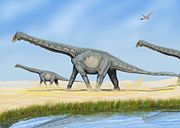
Lancian
Encyclopedia
Geology
Terrestrial sedimentary strata from the Judithian to the Lancian are generally regressive through-out the entire sequence, so the preserved changes in fossil communities represent not only phylogenetic changes but ecological zones from the submontane habitats to near-sea level coastal habitats.Paleobiogeography
By the Lancian hadrosaurs are no longer the dominant inhabitant of any province of western North America. Lehman records two surviving chasmosaurs, Triceratops and Torosaurus. It has recently been suggested that these two genera may be synonymous. EdmontosaurusEdmontosaurus
Edmontosaurus is a genus of crestless hadrosaurid dinosaur. It contains two species: Edmontosaurus regalis and Edmontosaurus annectens. Fossils of E. regalis have been found in rocks of western North America that date from the late Campanian stage of the Cretaceous Period 73 million years ago,...
and the less common Anatotitan
Anatotitan
Anatotitan is a genus of flat-headed or hadrosaurine hadrosaurid ornithopod dinosaur from the very end of the Cretaceous Period, in what is now North America...
are the only known surviving hadrosaurs. Both lack the elaborate ornamentation of their predecessors. In the south the transition to the Lancian is even more dramatic, which Lehman describes as "the abrupt reemergence of a fauna with a superficially "Jurassic" aspect." These faunas are dominated by Alamosaurus
Alamosaurus
Alamosaurus is a genus of titanosaurian sauropod dinosaur from the Late Cretaceous Period of what is now North America. It was a large quadrupedal herbivore. Isolated vertebrae and limb bones indicate that it reached sizes comparable to Argentinosaurus and Puertasaurus, which would make it the...
and feature abundant Quetzalcoatlus
Quetzalcoatlus
Quetzalcoatlus was a pterodactyloid pterosaur known from the Late Cretaceous of North America , and one of the largest known flying animals of all time. It was a member of the Azhdarchidae, a family of advanced toothless pterosaurs with unusually long, stiffened necks...
in Texas.

Jack Horner
Jack Horner may refer to:*Jack Horner , a character from the comic book, Fables, created by Bill Willingham, based on the nursery rhyme character*Jack Horner , Gordon John Horner, Minnesota sportscaster...
speculated that a rise in sea level during the Bearpaw Transgression created selective pressure as coastal lowlands were swallowed up the sea, resulting in anagenesis
Anagenesis
Anagenesis, also known as "phyletic change," is the evolution of species involving an entire population rather than a branching event, as in cladogenesis. When enough mutations have occurred and become stable in a population so that it is significantly differentiated from an ancestral population,...
. If the geographic range of some dinosaur species were truly as limited as the fossil record suggests, then a rapid rise and in sea level could cause intense pressure even the event was local. Additionally, a rapid drop in sea level could allow for "rapid colonization by a few dinosaur generalists." The appearance or reappearance of basal neoceratopsians could be explained by immigration from Asia. Dinosaurs like Nodocephalosaurus
Nodocephalosaurus
Nodocephalosaurus is a genus of herbivorous ankylosaurine ankylosaurid dinosaur from Upper Cretaceous deposits of San Juan Basin, New Mexico. The holotype was recovered from the Late Campanian De-na-zin Member of the Kirtland Formation and consists of an incomplete skull...
resembled Asian forms, and some like Saurolophus co-occurred in Asia as well as North America. Potential Asian immigrants were especially common in upland environments. The appearance of Alamosaurus may have represented an immigration event from South America. Some taxa may have co-occurred on both continents, including Kritosaurus and Avisaurus. Alamosaurus appears and achieves dominance in its environment very abruptly. Some scientists speculated that Alamosaurus was an immigrant from Asia. Inhabitants of upland environment are more likely to be endemic than coastal species, and tend to have less of an ability to cross bodies of water. Further, early cretaceous titanosaurs were already known, so North American potential ancestors for Titanosauru already existed. Quetzalcoatlus also had precursors in North America and its apparent rise to widespreadness may represent the expansion of its preferred habitat rather than an immigration event. Early Cretaceous
Early Cretaceous
The Early Cretaceous or the Lower Cretaceous , is the earlier or lower of the two major divisions of the Cretaceous...
deposits in North America reveal that basal neoceratopsian were already present on the continent before their apparent reemergence in the Lancian, so an immigration event from Asia is unnecessary to explain their appearance. The major potential immigrants represent archaic forms that probably wouldn't have directly competed with the disappearing forms anyway. Lehman described the evidence for immigration as a driving force in Lancian dinosaur faunal turnovers as "not particularly compelling."
The faunal turnover may be explained by the descent of more primitive forms existing in upland refugia characterized by conifer-dominated flora into areas that were formerly coastal lowlands as the seas retreated and conditions became more arid.
The decline of mammal diversity in Western North America from the Miocene to present primarily effected large herbivores and occurred over roughly the same length of time as the Late Cretaceous changes, and so may be parallel. They have many commonalities, including the replacement of diversity with single species environments caribou in the north, bison
Bison
Members of the genus Bison are large, even-toed ungulates within the subfamily Bovinae. Two extant and four extinct species are recognized...
to the south. The most spectacular and specialized forms went extinct. The turnover was preceded by an episode of immigration. Associated with the rapid expanse of terrestrial habitat due to melting glaciars. By contrast, with the mammalian turnovers the newly emerging dominant fauna were clearly old world immigrants, the cervids and bovids.

Reference
- Lehman, T. M., 2001, Late Cretaceous dinosaur provinciality: In: Mesozoic Vertebrate Life, edited by Tanke, D. H., and Carpenter, K., Indiana University Press, pp. 310–328.

